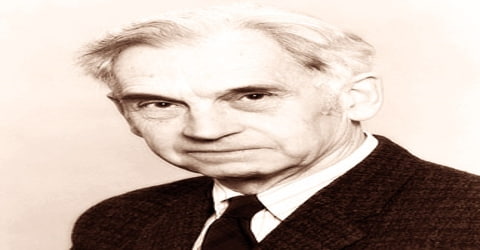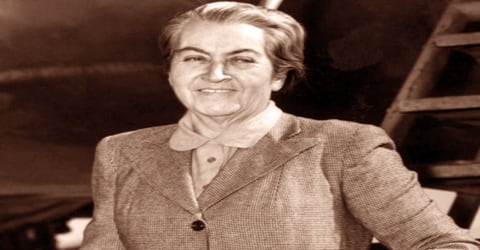Biography of Konrad Emil Bloch
Konrad Emil Bloch – German American biochemist.
Name: Konrad Emil Bloch
Date of Birth: 21 January 1912
Place of Birth: Nysa, Poland
Date of Death: 15 October 2000 (aged 88)
Place of Death: Lexington, Massachusetts, United States
Occupation: Biochemists
Father: Fritz Bloch
Mother: Hedwig Née Striemer
Spouse/Ex: Lore Teutsch (m. 1941)
Children: 2
Early Life

A German-born American biochemist who shared the 1964 Nobel Prize for Physiology or Medicine with Feodor Lynen for their discoveries concerning the natural synthesis of cholesterol and fatty acids, Konrad Emil Bloch was born 21st January 1912, in the German town of Neisse (now Nysa, Poland) to Frederich (Fritz) D. Bloch and Hedwig Bloch. Bloch’s investigations of the complex processes by which animal cells produce cholesterol have increased our understanding of the biochemistry of living organisms and have helped further research into the treatment of various common diseases.
Bloch was a Jew and had to escape Nazi Germany following the rise of Adolf Hitler to power. He took refuge initially in Switzerland and later America, eventually becoming a naturalized American citizen. He conducted significant research work in America. His studies regarding the complex procedures applied by animal cells to produce cholesterol made the biochemistry of living animals more comprehensible. These investigations of Bloch manifested the significance of cholesterol in cells of animals and aided in laying the foundation for further research work on the analysis and cure of different common ailments. He also analyzed all the twenty-seven carbon atoms present in the cholesterol molecule. Through his investigations, he displayed that the organic molecule called cholesterol evolves the natural steroid-related substances in human being. Many steps involved in the conversion of acetate to cholesterol were established by him. During the later stage of his career, he examined the metabolism of olefinic fatty acids as also researched on the vital antioxidant called glutathione, which aided protein metabolism.
Childhood, Family and Educational Life
Konrad E. Bloch, in full Konrad Emil Bloch, was born on January 21, 1912, in Neisse, Upper Silesia, at that time a part of the German Empire, in a middle-class family to Fritz Bloch and Hedwig née Striemer as their second child.
Bloch studied in an elementary school followed by the Realgymnasium. He moved to Munich in 1930 and enrolled at the “Technical University of Munich’ (TUM) to study chemistry and chemical engineering. Soon he became interested in organic chemistry and was highly motivated by the teaching of German organic chemist and Nobel Laureate Hans Fischer. He used to hear great organic chemists like Rudolf Willstätter, Heinrich Wieland and Adolph Windaus while attending the Sessions of the Münchener Chemische Gesellschaft. These great scientists reporting on their research work on enzymes, steroids, and porphyrins in such sessions had an immense influence on him.
In 1934, due to the Nazi persecutions of Jews, Bloch fled to the Schweizerische Forschungsinstitut in Davos, Switzerland, before moving to the United States in 1936. Later he was appointed to the department of biological chemistry at Yale Medical School. Bloch earned a degree in 1934, the year after Adolf Hitler (1889-1945) became chancellor (leader) of Germany.
In 1936 Bloch moved to the United States where he joined the ‘Columbia University’ following the advice of late Max Bergmann and receiving generous aid from the ‘Wallerstein Foundation’. He enrolled at the College of Physicians and Surgeons of the university in the Department of Biochemistry. He came under the guidance of Professor of Biological Chemistry Hans T. Clarke and in 1938 he completed his Ph.D. in biochemistry from the university.
Personal Life
Konrad Emil Bloch first met his future wife Lore Teutsch in Munich and married her in the United States in 1941. They were blessed with two children, son, Peter, and daughter, Susan.
Bloch was a music lover, enjoyed tennis and skiing and was well-known for his modesty.
Career and Works

After receiving a chemical engineering degree in 1934 at the Technische Hochschule in Munich, Konrad Emil Bloch went to Switzerland and then to the United States. At Columbia University (where he obtained his Ph.D. in 1938) he became a research associate of Rudolf Schoenheimer in the isotopic analysis of cell metabolism. After teaching at the University of Chicago (1946-54), Bloch became a professor of biochemistry at Harvard, continuing his research on lipids, especially the unsaturated fatty acid components; he was named professor emeritus in 1982. He wrote several books, including Blondes in Venetian Paintings, the Nine-Banded Armadillo, and Other Essays in Biochemistry (1994).
Bloch stayed in Columbia from 1939 to 1946 and worked with Schoenheimer and his associate, US biochemist David Rittenberg for a few years. He came to know regarding the use of radioisotopes while working with Schoenheimer and his research team. According to Bloch, he developed an enduring interest in the study of intermediary metabolism as also the issues of biosynthesis. Following the death of Schoenheimer in 1941, Bloch collaborated with Rittenberg and commenced work on biological synthesis of cholesterol. Through their investigations, they found acetate as a key component of cholesterol. This marked the beginning of his research on the complicated pattern of steps in the biological synthesis of cholesterol, a subject that he worked on for almost twenty years.
Cholesterol, which is found in all animal cells, contains twenty-seven carbon atoms in each molecule. It plays an essential role in the cell’s functioning, as it stabilizes cell membrane (walls of the cell). Before Bloch’s research, scientists knew little about cholesterol, although many believed there was a connection between the amount of cholesterol and other fats in the diet and arteriosclerosis (an unhealthy buildup of cholesterol deposits inside the arteries).
In 1942 Bloch and David Rittenberg discovered that the two-carbon compound acetic acid was the major building block in the 30 or more steps in the biosynthesis (natural formation) of cholesterol, waxlike alcohol found in animal cells. In his search to determine how acetic acid molecules combine in this process, Bloch was also joined by Feodor Lynen and his collaborators in Munich and Sir John Warcup Cornforth and George Popják in England. Their discovery facilitated medical research on the relation of blood cholesterol levels to atherosclerosis, research in physiology, and research on the chemistry of terpenes, rubber, and other isoprene derivatives.
In 1944 Bloch became a naturalized citizen of the US. He moved to Chicago in 1946 where he was inducted as Assistant Professor of Biochemistry in the ‘University of Chicago’. Apart from his investigations on the biosynthesis of cholesterol he also began examining the enzymatic synthesis of tripeptide glutathione along with J. Snoke. He received ‘Guggenheim Fellowships’, awarded annually by ‘John Simon Guggenheim Memorial Foundation’, thrice in 1953, 1960 and 1975.
Between 1946 and 1954 Bloch continued his research into the origin of all twenty-seven carbon atoms in the cholesterol molecule. Bloch’s research explained the significance of acetic acid as a building block of cholesterol and showed that cholesterol is an essential component of all body cells. In fact, Bloch discovered that all steroid-related substances (hormones, or substances released by organs for the organic process) in the human body are derived from cholesterol.
In 1953, Bloch spent an extremely fruitful year in Zurich with Croatian-Swiss scientist and Nobel Laureate L. Ruzicka and Croatian-Swiss organic chemist V. Prelog and their associates at the ‘Organisch-Chemisches Institut’, ‘Eidgenössische Technische Hochschule’. He was inducted in the ‘Harvard University’ in 1954 in its ‘Department of Chemistry’ as Higgins Professor of Biochemistry. Later in 1968, he was made Chairman of the Department.
Bloch shared the Nobel Prize in Physiology or Medicine in 1964 with Feodor Lynen, for their discoveries concerning the mechanism and regulation of the cholesterol and fatty acid metabolism. Their work showed that the body first makes squalene from acetate over many steps and then converts the squalene to cholesterol. He traced all the carbon atoms in cholesterol back to acetate. Some of his research was conducted using radioactive acetate in bread mold: this was possible because fungi also produce squalene. He confirmed his results using rats. He was one of several researchers who showed that acetyl-Coenzyme A is turned into mevalonic acid. Both Bloch and Lynen then showed that mevalonic acid is converted into chemically active isoprene, the precursor to squalene. Bloch also discovered that bile and a female sex hormone were made from cholesterol, which led to the discovery that all steroids were made from cholesterol. His Nobel Lecture was “The Biological Synthesis of Cholesterol.”
As fungi also produced squalene, Bloch and his colleagues used radioactive acetate in bread mould and gradually discovered that the origin of carbon atom in cholesterol came from the two-carbon molecule of acetate. This study of Bloch showed the importance of acetic acid in the formation of cholesterol as also the significance of cholesterol as a component of body cells. He found out that bile as well as a female sex hormone was made of cholesterol and eventually discovered that each steroid-related substance in the human body is derived from cholesterol. His research work on different aspects of terpene and sterol biogenesis continued. He also developed an interest in studying the enzymatic formation of unsaturated fatty acids as also the different facets of biochemical evolution.
Bloch’s work is significant because it contributed to creating “an outline for the chemistry of life,” as E. P. Kennedy and F. M. Westheimer of Harvard wrote in Science. More importantly, his contributions to understanding the biosynthesis of cholesterol have contributed to efforts to understand the human body’s regulation of cholesterol levels in blood and tissue.
From 1966 to 1969 Bloche remained Chairman of the Section of Biochemistry at ‘National Academy of Sciences’. In 1967 he became President of ‘American Society of Biological Chemists’. He was conferred with an honorary doctorate by many universities including ‘Columbia University’ in 1967, Munich’s ‘Technische Hochschule’ in 1968 and ‘Brandeis University’ in 1970. ‘International Union of Biochemistry’ made him the Chairman of its National Committee in 1968. He was a member of several academies and societies such as ‘American Academy of Arts and Sciences’, ‘National Academy of Sciences U. S.’ and ‘American Society of Biological Chemists’. He was a Senior Fellow of the ‘Australian Academy of Science’ and an honorary member of ‘Lombardy Academy of Sciences’. Post-retirement from ‘Harvard University’, he served the ‘College of Human Sciences’ at the ‘Florida State University’ as the Mack and Effie Campbell Tyner Eminent Scholar Chair. He became a Fellow of the ‘Royal Society’ in 1985.
Bloch was known for his extreme modesty. When he was awarded the Nobel Prize, the New York Times reported that he refused to have his picture taken in front of a sign that read, “Hooray for Dr. Bloch!”
Awards and Honor
In 1964 Konrad Emil Bloch was awarded the ‘Nobel Prize in Physiology or Medicine’ along with Feodor Lynen.
Death and Legacy
Konrad Emil Bloch died in Lexington, Massachusetts of congestive heart failure in 2000, aged 88. His wife Lore Bloch died in 2010 aged 98.
His work on biosynthesis of cholesterol not only manifested the importance of cholesterol in the human body but also contributed towards further research to understand how the human body regulates the level of cholesterol in blood and tissue.
According to the Harvard University Gazette, Dean Jeremy R. Knowles called Bloch, “a marvelously perceptive biochemist and genius,” and added that Bloch’s “deep understanding of metabolism laid the chemical foundations of today’s biology.”
Information Source:
















